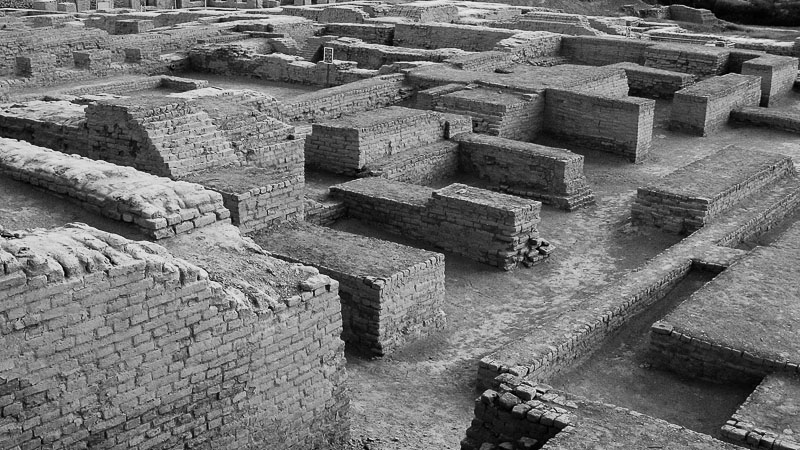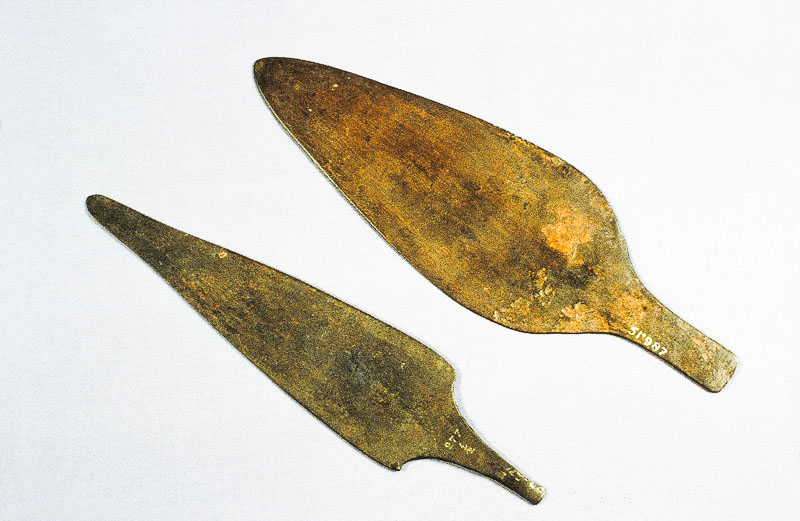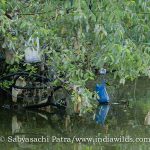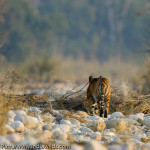IndiaWilds Newsletter Vol. 6 Issue III
Climate Change is Real
It is often mistakenly thought that climate change is a recent phenomenon. Scientists and conversationists often pepper their conversations with the statement the spectre of climate change is looming large indicating that if we dont mend our ways to reduce our carbon footprint then climate change will be upon us and the impact will be highly deleterious for mankind. However, little did we know that the climate change is a reality and the earth had witnessed climate change in earlier era and had to pay dearly.
Climate Change Claims Harappa:
The Indus valley civilization in Harappa and Mohenjodaro had often been a mystery to not only us but also scientists as this civilisation seems to have been suddenly wiped out from the face of earth. The human settlements at Harappa and Mohenjodaro were meticulously planned with roads, road crossings, drainage, public spaces, granary, burial places carefully planned. It fits in with the modern concept of city planning.
As opposed to the other civilisations like Egypt where the king or pharaoh is deified, the Indus valley civilisation seems to be a democractic society. So there have been many scientific studies to understand the sudden disappearance of this society as there can be learnings for us as well.
In a path breaking study, published in Geology (Abrupt weakening of the summer monsoon in northwest India 4100 yr ago, Y. Dixit, Geology, 2014) palaeoclimatologist Yama Dixit and team found out that between 4000 and 4200 years ago, the annual monsoon rains had stopped for a continuous period of two hundred years. This finding was based on the study of Oxygen 18 versus Oxygen 16 isotope in the snail shells in Kotla Dahar.
When there is lack of precipitation water evaporates and the lighter O 16 isotope evaporates faster than the heavier O18 isotope. So the snail shells get enriched with the Oxygen 18 isotope during times of drought. Kotla Dahar being a closed rainfed basin, the study of the rare oxygen 18 isotope in the shells of snails becomes an accurate indicator to estimate the drought periods.
This lack of precipitation for a period of two hundred years would have resulted in unprecedented famine. The ghaggar river had gone underground and the lakes and other waterbodies died. As a result the mainly agrarian economy faced severe resource crunch. This unprecedented situation brought in cracks in the peaceful society and the marginalized communities were the first to suffer. Lack of water had severe consequences on the hygiene and infectious diseases became prevalent. Tuberculosis was one of the diseases that had become rampant at that time. Lack of water had severe consequences on the hygiene and infectious diseases became prevalent. Tuberculosis was one of the diseases that had become rampant at that time.
The severe resource crunch gave rise to social unrest and unleased tremendous violence. About 50% of the remains had cracks in their skulls indicating blow by axe or similar weapons. (Robbins Schug G, Blevins KE, Cox B, Gray K, Mushrif-Tripathy V (2013) Infection, Disease, and Biosocial Processes at the End of the Indus Civilization. PLoS ONE) The severe resource crunch gave rise to social unrest and unleased tremendous violence. About 50% of the remains had cracks in their skulls indicating blow by axe or similar weapons.
(Robbins Schug G, Blevins KE, Cox B, Gray K, Mushrif-Tripathy V (2013) Infection, Disease, and Biosocial Processes at the End of the Indus Civilization. PLoS ONE)
Harappa society which at its peak had about half a million people was not a small settlement. If such a meticulously planned city could fall prey to climate change, can it not have the same impact on us sometime in future?
The present day billion plus population of our country has started to grapple with water crisis in most parts of the country. Two southern states, Tamil Nadu and Karnataka, are locked in litigation over Kaveri water sharing and from time to time violent protests are seen in these two states. Delhi also faces the problem of water as the Yamuna river, due to the diversion of water has lost its ability to heal.
Our cities are growing bigger and bigger increasing the challenge of water supply to the masses. To cater to the needs of these burgeoning population, water from rivers are diverted by canals. This reduces the flow of the original rivers and impacts the health of the rivers and its ecosystem. The leakage of water from taps in the households as well as from the supply lines often goes unnoticed. Neither the comman man nor the politicians give a thought that water is a finite resource. With unabated populism regarding urban water supply continues without any thought that our rivers are dying due to sewage and industrial pollution, diversion of water via canals and dam constructions.
An IPCC (Intergovernmental Panel on Climate Change) report had estimated that the Himalayan glaciers are receeding at the rate of 10 to 12 meters a year which is three times faster than it was two hundred years ago. If the present situation continues then these glaciers can completely vanish by the year 2035. This will severely impact the rivers like Ganga and Bramhaputra originating from the Himalaya making them completely dry up during summer months or reduce the flow to a trickle. Apart from severely denting the psyche of millions of people who revere these rivers as Gods, lack of water would be a death knell for agriculture, industries and the overall economy and the society will be in strife.
Climate change opening a Pandoras box:
To add to the strife, there are chances that the receeding glaciers in the Himalaya may expose virusus that have been dormant for thousands of years and bring them back to life. A study published in PNAS (Thirty-thousand-year-old distant relative of giant icosahedral DNA viruses with a pandoravirus morphology, Legendre et al), has found a giant virus named Pithovirus sibericum while digging 30 meters in the Siberian permafrost. This giant virus, namedPithovirus sibericum, was isolated from a >30,000-y-old radiocarbon-dated sample when we initiated a survey of the virome of Siberian permafrost. The revival of such an ancestral amoeba-infecting virus used as a safe indicator of the possible presence of pathogenic DNA viruses, suggests that the thawing of permafrost either from global warming or industrial exploitation of circumpolar regions might not be exempt from future threats to human or animal health.
“This is the first time we’ve seen a virus that’s still infectious after this length of time,” said Professor Jean-Michel Claverie, from the National Centre of Scientific Research (CNRS) at the University of Aix-Marseille in France. “This is the first time we’ve seen a virus that’s still infectious after this length of time,” said Professor Jean-Michel Claverie, from the National Centre of Scientific Research (CNRS) at the University of Aix-Marseille in France.
Pithovirus sibericum at 1.5 nanometers is so big that it can be seen under a microscope. Fortunately it is harmless to humans. However, there might be other deadly viruses stored deep in the glaciers, thawed by the extreme cold and can spring back to life when the glaciers melt. Even infectious diseases which were supposed to be eradicated may be stored in these glaciers and can come back to haunt us. When ancient viruses come back, it becomes difficult to control because our bodies may no longer be immune to them and by the time modern medical system throws up an effective medicine, these viruses can create catastrophic damage. And if such an event happens during times of resource crunch induced by climate change, there may not be enough resources as well as well as the will to fight such malevolent viruses. Pithovirus sibericum at 1.5 nanometers is so big that it can be seen under a microscope.
Fortunately it is harmless to humans. However, there might be other deadly viruses stored deep in the glaciers, thawed by the extreme cold and can spring back to life when the glaciers melt. Even infectious diseases which were supposed to be eradicated may be stored in these glaciers and can come back to haunt us.
The human induced changes is taking a big toll on Mother Earth. The burgeoning population, green house gas emissions from vehicles, industries, thermal power plants, cutting down forests which otherwise help in carbon sequestration, a lifestyle which has more carbon footprint is increasingly threatening to pull down the very existence of life on earth. Unfortunately, neither we nor our decision makers seem to be giving any thought on climate change.
We have to wake up to the fact that Climate change is real. The first to succumb would be the poorest of the poor and the marginalized communities, as was seen in Harappa. The politicians will ignore these inconvenient truths. However, if we ignore then history will repeat itself.
IndiaWilds Campaign:
Barn Owl Hunting by villagers
A shocking practice of hunting barn owl by using catapult has come to light. IndiaWilds member Paramvir Singh found a villager with a barn owl near a hamlet called Lendipara, off Vajreshwari Road near the Tungareshwar Wildlife Sanctuary. A shocking practice of hunting barn owl by using catapult has come to light. IndiaWilds member Paramvir Singh found a villager with a barn owl near a hamlet called Lendipara, off Vajreshwari Road near the Tungareshwar Wildlife Sanctuary.
Owls are mercilessly hunted because of their use in blackmagic rituals. Since villagers use catapult to hunt owls and other birds, it wont attract attention due to lack of sound. Unfortunately, catapult is not classified as a weaponIn the Wildlife Protection Act (WPA). In the WPA the definition of weapon includes ammunition, bows and arrows, explosives, firearms, hooks, knives, nets, poison, snares, traps, and any instrument or apparatus capable of anaesthetizing, decoying, destroying, injuring or killing an animal.This seemingly harmless play thing causes huge damage in the hands of experts. So we need to also raise our voice to ban catapult.
The killing of owls continue due to lack of documentation and lack of intelligence gathering by the forest department to prevent wildlife crimes. Unfortunately, in many parts of the country these crimes are ignored by the forest department even when reported to them. This incident too has been duly reported to the DFO thane region. A covert study would definitely reveal many more instances given the brazen manner of this villager carrying away the barn owl. It would be helpful if everyone writes to the authorities mentioning these incident and urging them to take strong action.
Shri. Anwar Ahmed Shri. Anwar Ahmed
Conservator of Forest Conservator of Forest
cfwlthane@mahaforest.gov.in
Off. 022-25402522
Fax.022-25329865
cc: Shri. S.A.Thorat cc: Shri. S.A.Thorat
Additional Principal Chief Conservator of Forest
ccfwlmumbai@rediffmail.com
Off. 022-28692668
Fax.022-28692593
Detailed discussion on this can be found in this link: Detailed discussion on this can be found in this link:
http://www.indiawilds.com/forums/showthread.php?14140-Barn-Owl-Hunted-to-Death-and-soon-extinction
Local Stakeholders participation: Key to protecting the Himalayan rivers?
By Nishikant Gupta
The Indian Himalayan Rivers are a life-line for millions yet, facing severe threats. Can local stakeholders participation to conserve riverine ecosystems help in alleviating some of the threats? The Indian Himalayan Rivers are a life-line for millions yet, facing severe threats. Can local stakeholders participation to conserve riverine ecosystems help in alleviating some of the threats?
Other Conservation News:
Bihar developing India’s biggest grassland for tigers
Lakhimpurs killer tigress caught, released in Dudhwa
Equipment Discussions:
Canon announces Powershot G1 X Mark II
http://www.indiawilds.com/forums/showthread.php?13959-Canon-announces-Powershot-G1-X-Mark-II
Wilderness Updates:
The Mukki Angle of Kanha by Shyamala Kumar
http://www.indiawilds.com/forums/showthread.php?14109
Sounds of Nature
Dawn chorus at Satkosia Tiger Reserve
http://www.indiawilds.com/forums/showthread.php?14160-Dawn-at-Satkosia
Image of the Month
Golden-fronted leaf bird image of Jitendra Katre
http://www.indiawilds.com/forums/showthread.php?14125-Image-of-the-Month-February-2014
Wildlife Photography
Flying Malabar Squirrel by Murugan Anantharaman
http://www.indiawilds.com/forums/showthread.php?14015-Flying-Malabar-Squirrel
Leopard-Danger Unwinding by Shyamala Kumar
http://www.indiawilds.com/forums/showthread.php?14009-Leopard-Danger-Unwinding
Kid by Sabyasachi Patra
http://www.indiawilds.com/forums/showthread.php?13970-Kid
Wire tailed swallows by Roopak Gangadharan
http://www.indiawilds.com/forums/showthread.php?14052-Wire-tailed-swallows
Crested Hawk Eagle with Kill by Bibhav Behera
ttp://www.indiawilds.com/forums/showthread.php?14023-Crested-Hawk-Eagle-with-Kill
Siberian Stonechat by Mangru Minz
http://www.indiawilds.com/forums/showthread.php?13964-Siberian-Stonechat
Greylag Goose by Rajeev Khanna
http://www.indiawilds.com/forums/showthread.php?14066-greylag-goose
Rafter’s Nightmare by Kaling Dai
http://www.indiawilds.com/forums/showthread.php?14078-rafter-s-nightmare
Kumaon Himalayas by Sunil Purushe
http://www.indiawilds.com/forums/showthread.php?14054-Kumaon-Himalayas
Sultan of Ranthambore by Vipin Sharma
http://www.indiawilds.com/forums/showthread.php?13997-Sultan-of-Ranthambore
Bharal (Blue Sheep) by Sucheth Lingachar
http://www.indiawilds.com/forums/showthread.php?14062-Bharal-(-Blue-Sheep-)-Ladakh
Regards,
Sabyasachi Patra
Profile:http://www.indiawilds.com/about.htm
Contact:http://www.indiawilds.com/contact_us.php
Facebook:http://www.facebook.com/pages/IndiaWilds/132629240481
Diary:http://www.indiawilds.com/diary/
Equipment reviews:http://www.indiawilds.com/diary/category/equipment/
Forums:http://www.indiawilds.com/forums/index.php
IndiaWilds Channel:http://www.youtube.com/indiawilds
Please post your views and feedback in the comments below.
- GoPro Hero 12 Black - 6 September,2023
- Leopards: The Last Stand - 2 July,2023
- Drifting in the Waters of Sundarbans - 26 March,2023


















Leave a Reply